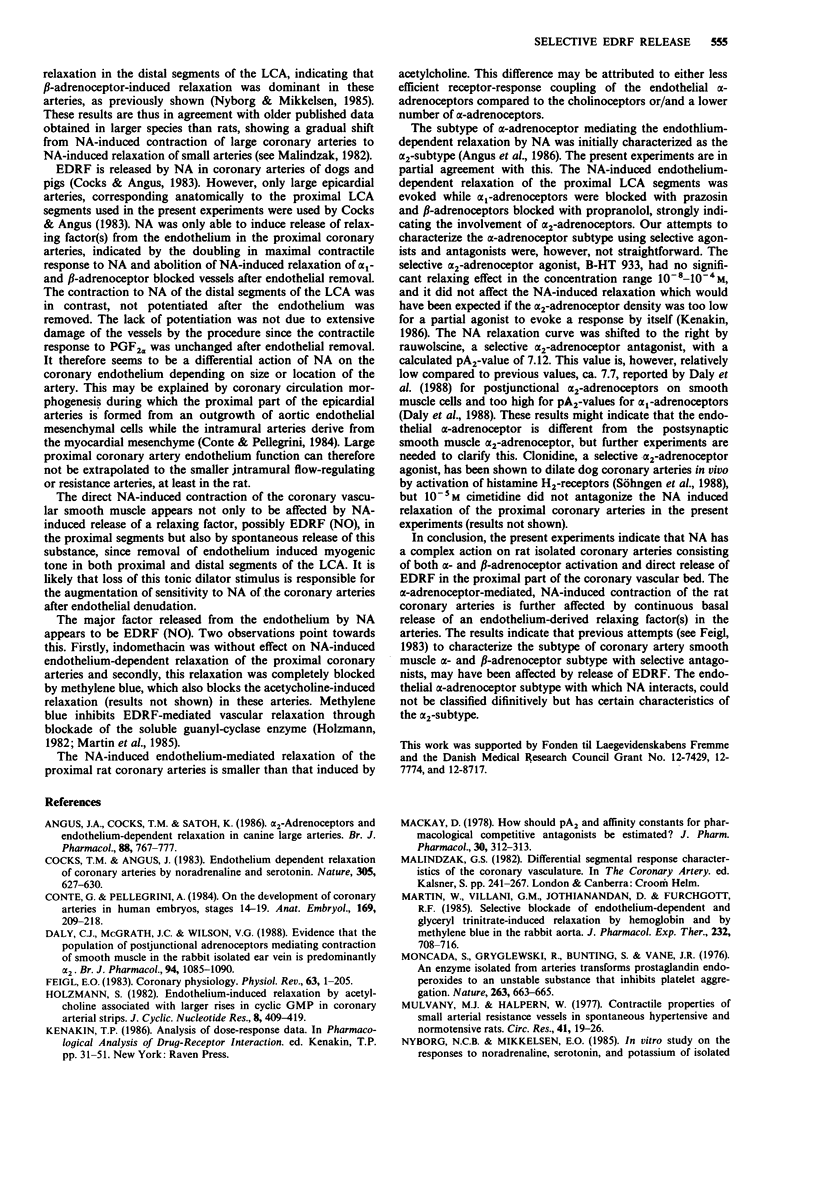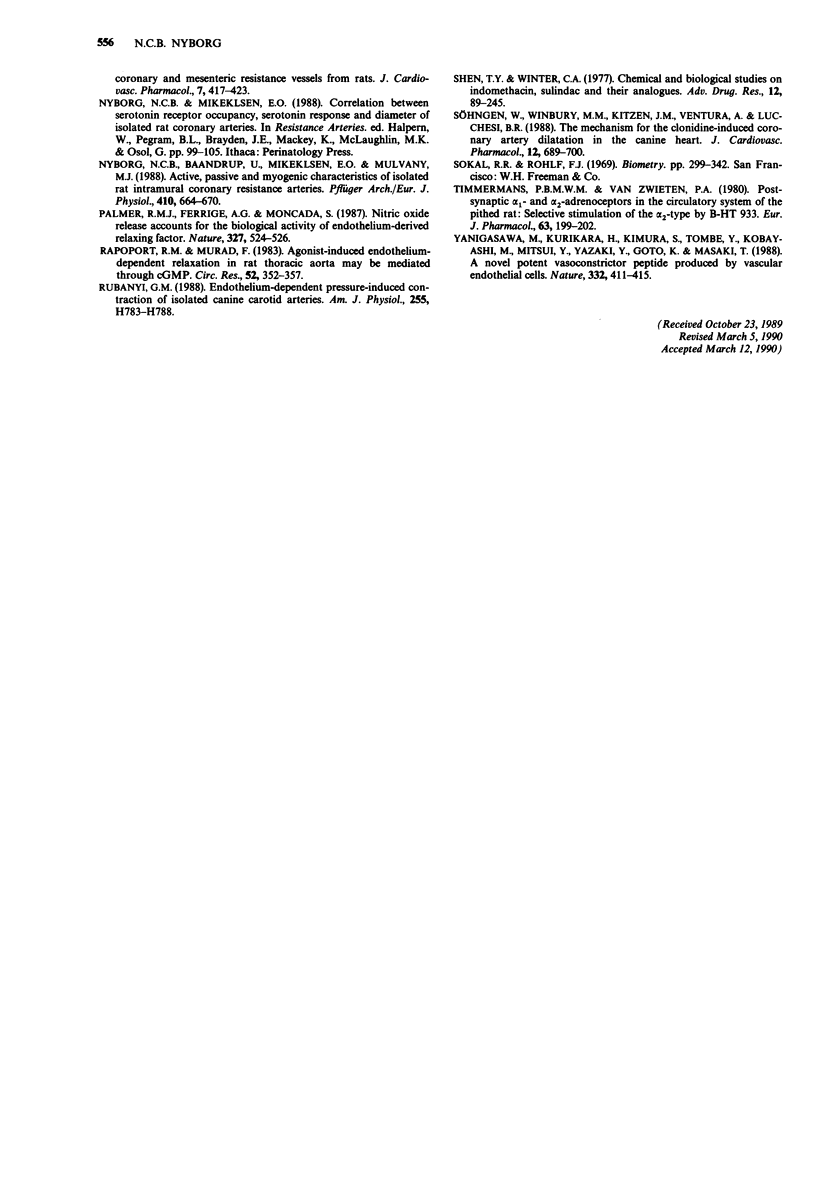Abstract
1. The effect of noradrenaline (NA) on the vascular smooth muscle and endothelial cells in isolated ring segments from the proximal and distal part of the left coronary artery (LCA) in rats was examined. 2. NA had a weak concentration-dependent contractile effect on proximal but relaxed distal segments of the LCA. The maximal NA-induced contraction of the proximal segments was doubled while the relaxation of the distal LCA segments was converted to a contraction after blockade of beta-adrenoceptors with propranolol 3 x 10(-6) M, thus indicating the presence of both alpha- and beta-adrenoceptors in the arteries, with dominance of alpha-adrenoceptors and of beta-adrenoceptors in the proximal and distal segments of the LCA, respectively. 3. The contractile effect of NA (beta-adrenoceptors blocked) was doubled in the proximal LCA segments after the endothelium was removed. Endothelial denudation had, in contrast, no potentiating effect on the contractile response of the distal arteries to NA. Both proximal and distal segments became more sensitive to the contractile action of NA after removal of the endothelium. 4. The spontaneous myogenic tone increased in both proximal and distal LCAs after endothelial removal, indicating spontaneous release of a relaxing endothelial factor in the vessels. 5. Following contraction with prostaglandin F2 alpha (PGF2 alpha), and in the presence of propranolol, 3 x 10(-6) M, and prazosin, 10(-6) M, NA induced an endothelium-dependent relaxation of only proximal but not distal segments of the precontracted LCA.(ABSTRACT TRUNCATED AT 250 WORDS)
Full text
PDF




Selected References
These references are in PubMed. This may not be the complete list of references from this article.
- Angus J. A., Cocks T. M., Satoh K. Alpha 2-adrenoceptors and endothelium-dependent relaxation in canine large arteries. Br J Pharmacol. 1986 Aug;88(4):767–777. doi: 10.1111/j.1476-5381.1986.tb16249.x. [DOI] [PMC free article] [PubMed] [Google Scholar]
- Cocks T. M., Angus J. A. Endothelium-dependent relaxation of coronary arteries by noradrenaline and serotonin. Nature. 1983 Oct 13;305(5935):627–630. doi: 10.1038/305627a0. [DOI] [PubMed] [Google Scholar]
- Conte G., Pellegrini A. On the development of the coronary arteries in human embryos, stages 14-19. Anat Embryol (Berl) 1984;169(2):209–218. doi: 10.1007/BF00303151. [DOI] [PubMed] [Google Scholar]
- Daly C. J., McGrath J. C., Wilson V. G. Evidence that the population of postjunctional-adrenoceptors mediating contraction of smooth muscle in the rabbit isolated ear vein is predominantly alpha 2. Br J Pharmacol. 1988 Aug;94(4):1085–1090. doi: 10.1111/j.1476-5381.1988.tb11626.x. [DOI] [PMC free article] [PubMed] [Google Scholar]
- Feigl E. O. Coronary physiology. Physiol Rev. 1983 Jan;63(1):1–205. doi: 10.1152/physrev.1983.63.1.1. [DOI] [PubMed] [Google Scholar]
- Holzmann S. Endothelium-induced relaxation by acetylcholine associated with larger rises in cyclic GMP in coronary arterial strips. J Cyclic Nucleotide Res. 1982;8(6):409–419. [PubMed] [Google Scholar]
- MacKay D. How should values of pA2 and affinity constants for pharmacological competitive antagonists be estimated? J Pharm Pharmacol. 1978 May;30(5):312–313. doi: 10.1111/j.2042-7158.1978.tb13237.x. [DOI] [PubMed] [Google Scholar]
- Martin W., Villani G. M., Jothianandan D., Furchgott R. F. Selective blockade of endothelium-dependent and glyceryl trinitrate-induced relaxation by hemoglobin and by methylene blue in the rabbit aorta. J Pharmacol Exp Ther. 1985 Mar;232(3):708–716. [PubMed] [Google Scholar]
- Moncada S., Gryglewski R., Bunting S., Vane J. R. An enzyme isolated from arteries transforms prostaglandin endoperoxides to an unstable substance that inhibits platelet aggregation. Nature. 1976 Oct 21;263(5579):663–665. doi: 10.1038/263663a0. [DOI] [PubMed] [Google Scholar]
- Mulvany M. J., Halpern W. Contractile properties of small arterial resistance vessels in spontaneously hypertensive and normotensive rats. Circ Res. 1977 Jul;41(1):19–26. doi: 10.1161/01.res.41.1.19. [DOI] [PubMed] [Google Scholar]
- Nyborg N. C., Baandrup U., Mikkelsen E. O., Mulvany M. J. Active, passive and myogenic characteristics of isolated rat intramural coronary resistance arteries. Pflugers Arch. 1987 Dec;410(6):664–670. doi: 10.1007/BF00581329. [DOI] [PubMed] [Google Scholar]
- Nyborg N. C., Mikkelsen E. O. In vitro studies on responses to noradrenaline, serotonin, and potassium of intramyocardial and mesenteric resistance vessels from Wistar rats. J Cardiovasc Pharmacol. 1985 May-Jun;7(3):417–423. doi: 10.1097/00005344-198505000-00002. [DOI] [PubMed] [Google Scholar]
- Palmer R. M., Ferrige A. G., Moncada S. Nitric oxide release accounts for the biological activity of endothelium-derived relaxing factor. Nature. 1987 Jun 11;327(6122):524–526. doi: 10.1038/327524a0. [DOI] [PubMed] [Google Scholar]
- Rapoport R. M., Murad F. Agonist-induced endothelium-dependent relaxation in rat thoracic aorta may be mediated through cGMP. Circ Res. 1983 Mar;52(3):352–357. doi: 10.1161/01.res.52.3.352. [DOI] [PubMed] [Google Scholar]
- Rubanyi G. M. Endothelium-dependent pressure-induced contraction of isolated canine carotid arteries. Am J Physiol. 1988 Oct;255(4 Pt 2):H783–H788. doi: 10.1152/ajpheart.1988.255.4.H783. [DOI] [PubMed] [Google Scholar]
- Shen T. Y., Winter C. A. Chemical and biological studies on indomethacin, sulindac and their analogs. Adv Drug Res. 1977;12:90–245. [PubMed] [Google Scholar]
- Söhngen W., Winbury M. M., Kitzen J. M., Ventura A., Lucchesi B. R. The mechanism for the clonidine-induced coronary artery dilatation in the canine heart. J Cardiovasc Pharmacol. 1988 Dec;12(6):689–700. doi: 10.1097/00005344-198812000-00011. [DOI] [PubMed] [Google Scholar]
- Timmermans P. B., Van Zwieten P. A. Postsynaptic alpha 1- and alpha 2-adrenoceptors in the circulatory system of the pithed rat: selective stimulation of the alpha 2-type by B-HT 933. Eur J Pharmacol. 1980 May 2;63(2-3):199–202. doi: 10.1016/0014-2999(80)90446-x. [DOI] [PubMed] [Google Scholar]
- Yanagisawa M., Kurihara H., Kimura S., Tomobe Y., Kobayashi M., Mitsui Y., Yazaki Y., Goto K., Masaki T. A novel potent vasoconstrictor peptide produced by vascular endothelial cells. Nature. 1988 Mar 31;332(6163):411–415. doi: 10.1038/332411a0. [DOI] [PubMed] [Google Scholar]


